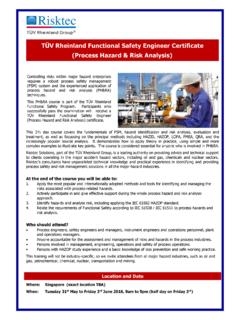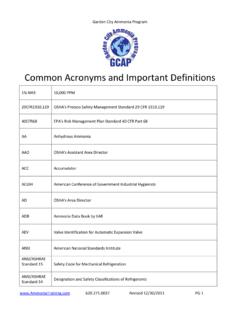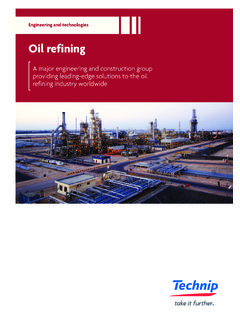Transcription of What is LOPA and Why Should I Care? - RMP Corp.
1 What is LOPA and Why Should I Care? John M. JohnsonRisk Management (877) 532-0806 M. JohnsonRisk Management Professionals Chemical Engineering University of California, Riverside - University of California, Riverside HAZOP/LOPA experience Upstream oil and gas Refinery Other chemical manufacturing facilities Ammonia Chlorine Quantitative Risk Analysis (QRA) Development of Operating Procedures and Control Narratives CalARP / RMP / PSM Program Development and AuditingKey Topics What is LOPA? Overview of LOPA Why do I care? Changes to Regulatory Framework Semi-Quantitative Analysis Easily Integrated into Qualitative Analysis ToolsWhat is Layer of Protection Analysis (LOPA)?Layer of Protection Analysis (LOPA) Semiquantitative risk assessment Evaluates the safety integrity of process operations Semiquantitative order of magnitude approximation Typically used after a qualitative hazard evaluation ( , HAZOP) Corporate policy Unsure of the frequency of ultimate consequence Unsure of the consequences High severity consequence Relies on Multi-Disciplined Team Implemented with pre-defined set of rules Published guidelines Intracompany defined criteriaLayer of Protection Analysis (LOPA) Risk Acceptance (Tolerance) Criteria Corporate policy Typically generated during HAZOP HAZOP Team ranks consequence as Severe Corporate policy is to perform LOPA on all Severity 2 RAC = 1 x 10-3 Impact Event Consequenceper Consequence Decision TreeRisk Acceptance Criteria(RAC)Events per YearCatastrophic (1)No more than once in 10,000 years (1 x 10-4)
2 Severe (2)No more than once in 1,000 years (1 x 10-3)Moderate (3)No more than once in 100 years (1 x 10-2)Low (4)No more than once in 10 years (1 x 10-1)Negligible (5)(1 x 100)Layer of Protection Analysis (LOPA) Initiating Event Frequency (Initiating Cause Likelihood) HAZOP Likelihood of the Ultimate potential Consequence LOPA Initiating Cause Likelihood Likelihood of operator misaligning valve, control system failure, etc. Company generated based off of literature review * , Unloading/Loading Hose Failure Literature 1 10-2(PER YEAR) Company 1 x 10-1(PER YEAR)* CCPS Layer of Protection Analysis: Simplified Process Risk assessment ** * CCPS Guidelines for Initiating Events and Independent Protection Layers**Initiating CauseFrequency (events per year)Human Error (routine task, performed once per week)100 Human Error (non-routine task, performed < once per month)10-1 BPCS control loop of Protection Analysis (LOPA) LOPA Ratio If LOPA Ratio 1, then existing protection layers are adequate Current example _ 3 2 1 _ 10 10 10 Layer of Protection Analysis (LOPA) Probability of Failure on Demand Value representing the probability of a system failing to respond at need What s the severity if we overpressure this vessel?
3 We can t overpressure, it s got a PSV - Quote from every HAZOP I ve ever been inLayer of Protection Analysis (LOPA) Independent Protection Layer (IPL) Independent of the initiating event Independent of other IPL s (safeguards) Follows specific guidelines as to applicability Switches Are the maintained, calibrated, and inspected at regular intervals Alarms Can an operator be expected to respond in time Pressure Relief Is it sized for the case under discussion Passive or ActiveLayer of Protection Analysis (LOPA) Enabling Conditions (modifies initiating event likelihood) A state that is not a failure/error but is conducive to generating the loss event, expressed as a probability Seasonal risks Process State risks Conditional Modifiers (modifies impact) The probability of detrimental impact if the loss event were to occur Probability that personnel are present at time of event Probability of ignitionLayer of Protection Analysis (LOPA) Values are documented and defensible Dispersion modeling Goes to probability of developing hazardous atmosphere Maintenance records Goes to demonstrating reliability of safeguards (IPL s) Policies and procedures or signage designating a hazardous work area Goes to personnel presence modifier Electrical Classification documentation Goes to probability of ignitionLayer of Protection Analysis (LOPA) LOPA Ratio If LOPA Ratio 1, then existing protection layers are adequate Probability of Failure on Demand _ 3 2 1 Independent Protection Layer (IPL)Probability of Failure on Demand (PFD)
4 BPCS10-1 Human Response to Abnormal Condition10-1 Spring Operated Pressure Relief of Protection Analysis (LOPA) LOPA Ratio If LOPA Ratio 1, then existing protection layers are adequate Current example Typically followed by recommendation to ensure device is added to critical instruments list Ensure Reliability _ 3 2 1 _ 1 10 10 1 Why Do I Care? Safeguard Protection Analysis (SPA)(CalPSM-R (e), CalARP ) Objectives: Assess the effectiveness of existing and combined safeguards for each failure scenario identified in the PHA Assure that safeguards are independent of the initiating event and each other Evaluate: Passive, Active, or Procedural Safeguards Using LOPA or equally effective method LOPA Summary(continued) LOPA can provide a vehicle for assimilating additional details, if needed, : More accurate failure rates & probabilities Results of detailed human error probability calculations, based on specific task analysis More accurate consequence modeling LOPA is best implemented using a team approach, similar to a HAZOP Study, and may be conducted during or immediately after the HAZOP Study.
5 The implementation of LOPA in tandem with the HAZOP Study is an excellent mechanism for verifying safeguard adequacy and providing a different perspective on the M. 282-0123(877)





